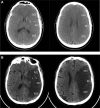Management of Acute Ischemic Stroke
- PMID: 32947473
- PMCID: PMC7540624
- DOI: 10.1097/CCM.0000000000004597
Management of Acute Ischemic Stroke
Abstract
Objectives: Concise "synthetic" review of the state of the art of management of acute ischemic stroke.
Data sources: Available literature on PubMed.
Study selection: We selected landmark studies, recent clinical trials, observational studies, and professional guidelines on the management of stroke including the last 10 years.
Data extraction: Eligible studies were identified and results leading to guideline recommendations were summarized.
Data synthesis: Stroke mortality has been declining over the past 6 decades, and as a result, stroke has fallen from the second to the fifth leading cause of death in the United States. This trend may follow recent advances in the management of stroke, which highlight the importance of early recognition and early revascularization. Recent studies have shown that early recognition, emergency interventional treatment of acute ischemic stroke, and treatment in dedicated stroke centers can significantly reduce stroke-related morbidity and mortality. However, stroke remains the second leading cause of death worldwide and the number one cause for acquired long-term disability, resulting in a global annual economic burden.
Conclusions: Appropriate treatment of ischemic stroke is essential in the reduction of mortality and morbidity. Management of stroke involves a multidisciplinary approach that starts and extends beyond hospital admission.
Conflict of interest statement
Dr. Rincon received funding from Bard, Portola Pharmaceuticals, and NeuroCrit, and he disclosed off-label product use of Targeted Temperature Management. Dr. Herpich has disclosed that he does not have any potential conflicts of interest.
Figures




Comment in
-
Appropriate Treatment of Ischemic Stroke That Is Essential for the Reduction of Mortality and Morbidity: Should We Use Hyperbaric Oxygen Therapy Together With Recombinant Tissue Plasminogen Activator for Improving Brain Oxygenation and Before Recombinant Tissue Plasminogen Activator to Minimize the Risk of Massive Bleeding?Crit Care Med. 2021 Aug 1;49(8):e806-e807. doi: 10.1097/CCM.0000000000004988. Crit Care Med. 2021. PMID: 34261938 No abstract available.
-
The authors reply.Crit Care Med. 2021 Aug 1;49(8):e807-e808. doi: 10.1097/CCM.0000000000005129. Crit Care Med. 2021. PMID: 34261939 No abstract available.
References
-
- The National Institute of Neurological Disorders and Stroke rt-PA Stroke Study Group: Tissue plasminogen activator for acute ischemic stroke. N Engl J Med. 1995; 333:1581–1587 - PubMed
-
- Prabhakaran S, Ruff I, Bernstein RA. Acute stroke intervention: A systematic review. JAMA. 2015; 313:1451–1462 - PubMed
-
- Jauch EC, Cucchiara B, Adeoye O, et al. Part 11: Adult stroke: 2010 American Heart Association guidelines for cardiopulmonary resuscitation and emergency cardiovascular care. Circulation. 2010; 12218 Suppl 3S818–S828 - PubMed
-
- Gyrd-Hansen D, Olsen KR, Bollweg K, et al. Cost-effectiveness estimate of prehospital thrombolysis: Results of the PHANTOM-S study. Neurology. 2015; 84:1090–1097 - PubMed
-
- Ebinger M, Kunz A, Wendt M, et al. Effects of golden hour thrombolysis: A Prehospital Acute Neurological Treatment and Optimization of Medical Care in Stroke (PHANTOM-S) substudy. JAMA Neurol. 2015; 72:25–30 - PubMed
Publication types
MeSH terms
LinkOut - more resources
Full Text Sources
Medical
Miscellaneous

